Have you ever felt like you’re playing an endless game of tag with your B2B content marketing strategy, trying to catch your target audience’s attention while they’re just out of reach?
If so, you’re not alone. We’ve all been there. But hey, don’t pull your hair out just yet. In this article, we’ll share the most effective, cutting-edge content marketing for B2B strategies that attract leads like a month to a flame.
With a blend of insights, real-world examples, and practical tips, we aim to equip you with tools and techniques that can help you drive engagement, build strong customer relationships, and propel your brand to the next level.
Sounds idyllic, right?
Let’s dive in.
Table of Contents
1. Leverage employee advocacy
Your employees are your greatest assets. So why not use them to your advantage in your B2B content marketing strategy?
But what does that mean? Well, think of your employees as your brand ambassadors — your secret marketing weapon.
Imagine this: your customer is scrolling through their social media feed, as they do dozens of times per day. Then, boom. They see a post from one of your employees talking about your latest product or sharing a behind-the-scenes snapshot of your team.
It’s not just any old marketing spiel — it’s a genuine, authentic endorsement. For instance, check out this LinkedIn post by a HubSpot recruiter:
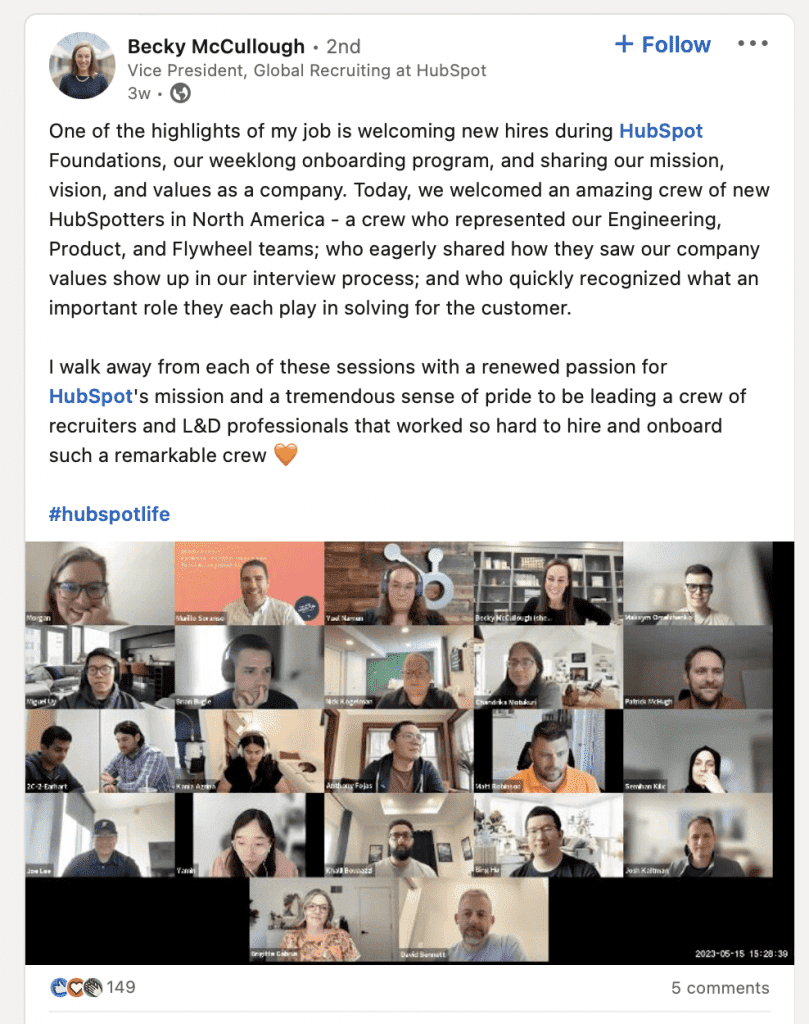
Pretty neat, huh? It gives people a behind-the-scenes look at HubSpot culture. It turns a faceless brand into something users can resonate with. It sparks a human connection.
The thing is, folks are more likely to trust an employee’s word over traditional advertising. It’s the personal touch that makes all the difference. Your employees are your boots on the ground, and their voices hold their weight in gold.
But remember, it’s not about twisting your employees’ arms to share company posts. It’s about incorporating social media recruitment strategies and building a company culture they’re proud to be part of and want to shout about on social media.
So how about that for a strategy? Tapping into your employees’ networks could mean reaching a whole new audience.
And the best part? It doesn’t need a colossal budget — it just needs a bit of thought, a sprinkle of creativity, and a heap of enthusiasm.
2. Create product-led content
Picture this: instead of creating different types of content about how super-duper your B2B product is, you showcase your product doing the talking. Or how it solves problems and makes your target audience’s life easier.
That’s product-led content in a nutshell. It’s not just about showing off your bells, whistles, and sleek design — it’s more about demonstrating the real value it offers to your B2B customers.
Think of product-led content like a teaser trailer. You’re giving your audience a glimpse of what’s to come. In other words, you’re not just telling them, “Hey, this product is great!”. Rather, you’re showing them why it’s great.
Thankfully, product-led engaging content doesn’t necessarily require a massive budget. All you need is a good understanding of your B2B product or service, creativity, and an authentic approach to your content ideas.
It could be as simple as a piece of content, like a blog post on how to make the most of your product, a how-to video, or even customer testimonials highlighting its impact. Remember, it’s not about hard selling — it’s about showing your audience the ‘why’ behind your product.
For example, Jeremy Moser does an excellent job sharing an in-depth video guide on how to score hundreds of backlinks with only two to three hours of work:
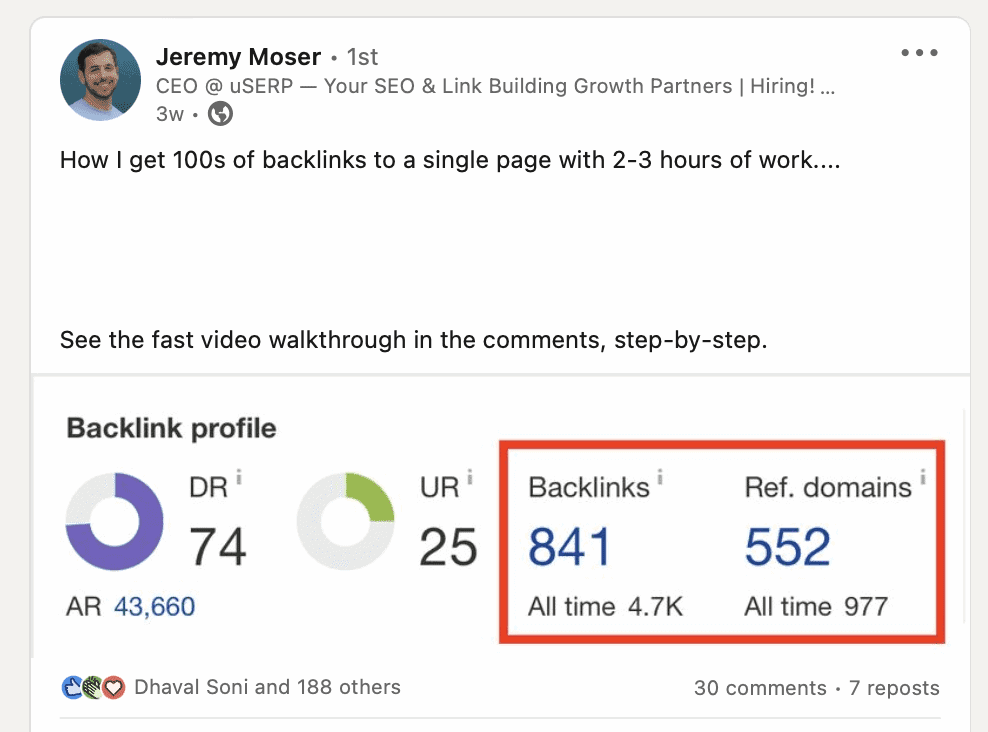
Jeremy is building authority in the SEO space by educating people with real examples of how to build high-quality backlinks. It doesn’t come off as spammy or overly promotional. He’s genuinely trying to provide value to his LinkedIn followers.
And by doing so, his viewers are getting indirect exposure to his SEO agency, uSERP, which can and will take on the heavy lifting for all things link building if viewers prefer to outsource.
In other words, it’s an excellent way to build brand awareness.
So, how can you implement this on your own? First, decide on the content assets where you want to plug your product. The ideal and most used content assets include blog posts, case studies, social media posts, and email newsletters. The last one can be especially beneficial after you learn how to monetize newsletter.
Additionally, it’s crucial to verify the email addresses to ensure deliverability and maintain a high-quality subscriber list. Then choose the product features or solutions you want to highlight, get to writing the meat and potatoes, and wrap it all up with a compelling call-to-action to convert leads into paying customers.
Conducting an email marketing audit can be an invaluable step in this process. By thoroughly reviewing your email campaigns, you can identify areas for improvement, refine your targeting, and ensure that your messages align with your brand’s goals and values. An email marketing audit can help you fine-tune your strategy, resulting in more effective email campaigns that drive better results and engagement.
3. Maximize case studies
Ah, social proof. The best way for B2B companies to build trust. Case studies help ideal prospects understand your company’s strengths, but they also indirectly promote your company. How?
Case studies serve as concrete proof of your business’s expertise, showcasing your track record of success. They offer a compelling blend of storytelling and statistics, illustrating how your product or service has solved real problems for real customers.
This tangible evidence can be more convincing to potential customers than any sales pitch or advertisement. Not to mention, case studies aren’t merely self-promotion. They focus on genuine problem-solving scenarios, demonstrating how your offerings have overcome challenges and delivered value.
Here are a few more benefits of using case studies in B2B content marketing that’ll indirectly elevate brand promotion:
- Efficient and scalable marketing asset: There’s no cap on the number of times you can use a single case study to share with a new potential customer to convince them to proceed with your product/services.
- Brings natural flow to the sales process: Even if the case study doesn’t have a direct call-to-action, it helps your sales team during the conversion phase of the sales funnel. They’re the real-world examples that show your potential customers, “Hey, look what we’ve done for others — we can do it for you too!”
ClickUp is a powerhouse in this arena. They feature dozens of case studies on a dedicated landing page, sharing valuable content backed by data.
They’re easy to read and help convince those B2B businesses who are on the fence by pushing them closer to the purchasing decision through proven results.
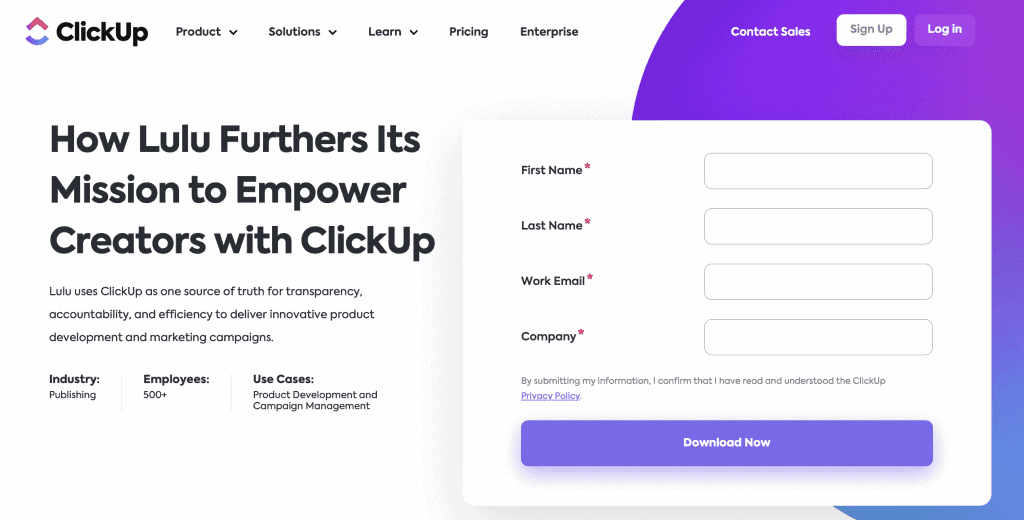
4. Use digital PR for brand promotion and reach
Digital PR increases your brand’s reach to prospective clients by featuring your company in authoritative publications, podcasts, and social media posts.
Let’s take a closer look at a few of the most popular content formats:
- Authoritative publications – Share insights about your business journey, experiences, or subject matter expertise with journalists, free press release distribution sites or via a guest post.
- Podcasts – Say yes to podcast appearances and share similar journeys, advice, and perspectives via an audio medium.
- Social media posts – Engage with your audience by responding to comments, sharing relevant content, and being part of the conversation.
Sounds fun, right? Now, let’s dive deeper and understand how these tactics will help content marketing for B2B leverage brand promotion:
- Improve search engine optimization (SEO): When your brand is mentioned on a high-ranking website via a backlink to your website, your ranking on search engines for the target keyword goes up.
- Build brand trust: When credible publications talk about your company positively, it educates people about your business and further builds your positive brand image.
- Generate leads: A successful PR strategy puts your products and services before interested prospects. The more visibility your brand gets and the more people talk about your company, the more traffic you’ll get on your website — ultimately generating more leads.
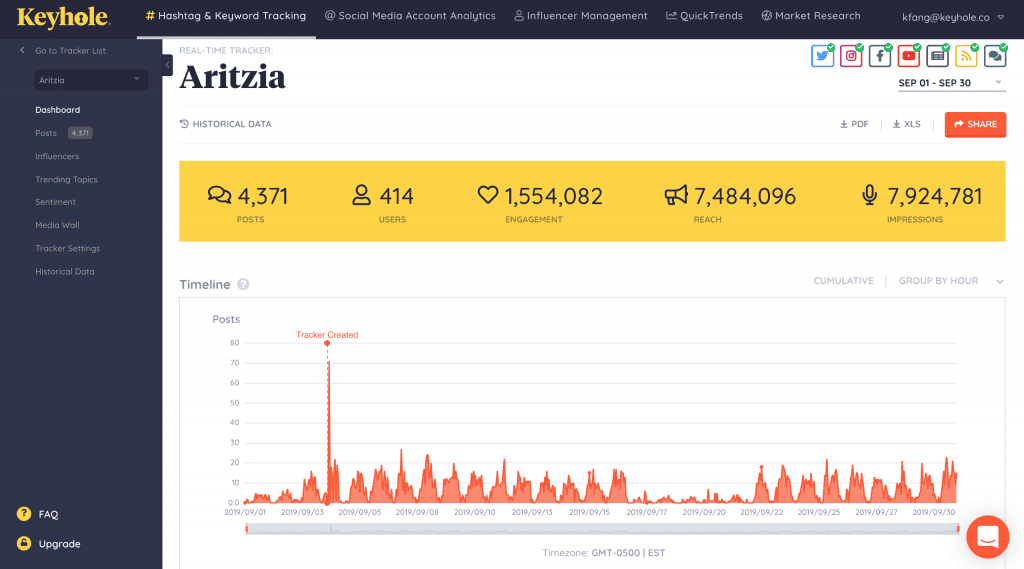
You can use Keyhole to dig out all your social media mentions. It even analyses the sentiment so you give a relevant reply to your audience.
5. Double down on educational videos and webinars
Navigating the B2B landscape is no small feat. B2B buyers are a discerning group, meticulous in their research before making purchasing decisions.
This conscientious approach isn’t arbitrary. Quite often, their purchase approval isn’t a one-person show — it leads to building a decision tree that involves multiple stakeholders.
The aim? To build a solid case for their purchase, strong enough to gain approval in a single round, thereby streamlining the buying process.
So this B2B content marketing strategy is about educating your audience and becoming their go-to resource for valuable industry insights.
That’s where webinars and videos come into play. Consider producing in-depth webinars that shed light on your products or services. Or maybe follow a winning video content strategy that dive into the latest industry trends, or reveal smart problem-solving techniques.
The key is to provide value, not just a sales pitch. So don’t just scratch the surface.
Dive into the nitty-gritty details that your audience is eager to understand. Share practical advice that they can implement straight away.
And offer actionable tips that show you’ve got your finger on the pulse of the market, like Codeless founder, Brad Smith, does here:
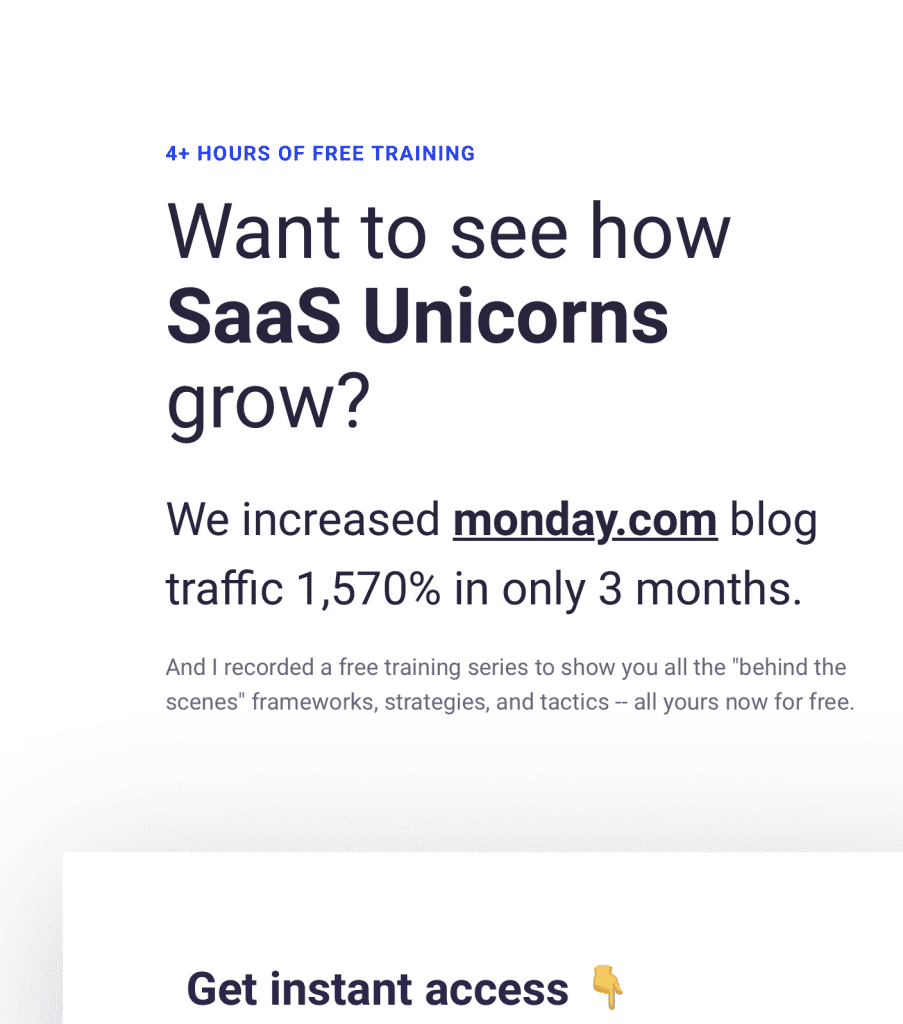
Remember, your audience has pain points and looks to you for solutions.
Why is this a winning strategy? Because it positions your brand as an expert in the field and builds trust with your audience. When people trust you, they’ll do business with you.
How to develop a B2B content marketing strategy like a pro
Here are a few simple tips from B2B marketers to B2B markets to stay organized and improve your content marketing strategy tenfold.
1. Outline your goals
The first step is to establish your content marketing goals. You might be thinking, “Of course, I need goals.” But trust us, you’d be surprised how many folks skip this step and end up in a tailspin.
So, here’s the lowdown: You need to know where you’re heading before you start the journey. To get to the bottom of your business goals, ask yourself a few of these questions:
- Do you want to be seen as an industry thought leader?
- Do you want to create heart-to-heart connections with B2B buyers?
- Do you want to publish long-form or short-form content?
Then, turn these aspirations into concrete goals. But to knock your content marketing goals out of the park, you need tight-knit workplace collaboration to keep your marketing team marching to the beat of the same drum.
That way, you can unleash the full potential of your employees and establish a culture of collaboration that fosters innovation and success by breaking down silos and fostering cross-functional teamwork.
And the secret sauce to keeping everyone in sync?
A shared Google calendar to set content development and publication deadlines, assign tasks, and track progress. This humble tool gives you a bird’s eye view of your entire operation.
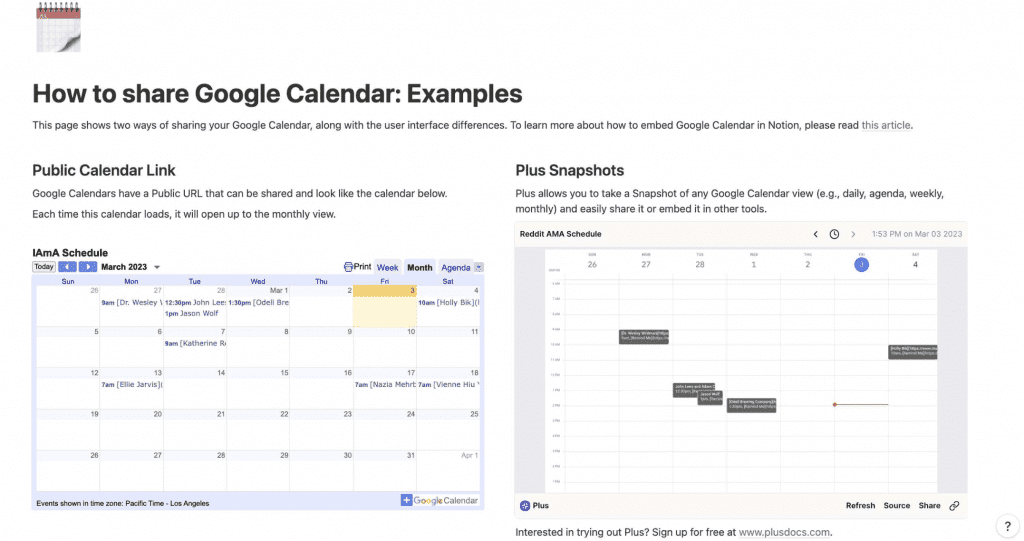
Visibility and accountability are the glue that holds your team together, especially when you have a motley crew of contributors. It helps build a well-oiled machine where everyone knows what they’re doing and when they’re doing it.
And the result? A content development process that’s as smooth as butter.
2. Create buyer personas
It’s not enough to know your customers’ businesses. You need to go a little deeper, a little more personal. Enter the realm of B2B buyer personas.
A buyer persona helps give you a clear picture of your ideal customer, what they need, and what keeps them up at night.
Are your buyers tech-savvy start-ups or old-school enterprises? What kind of content do they consume, and where do they hang out online? Are they risk-takers, or do they play it safe?
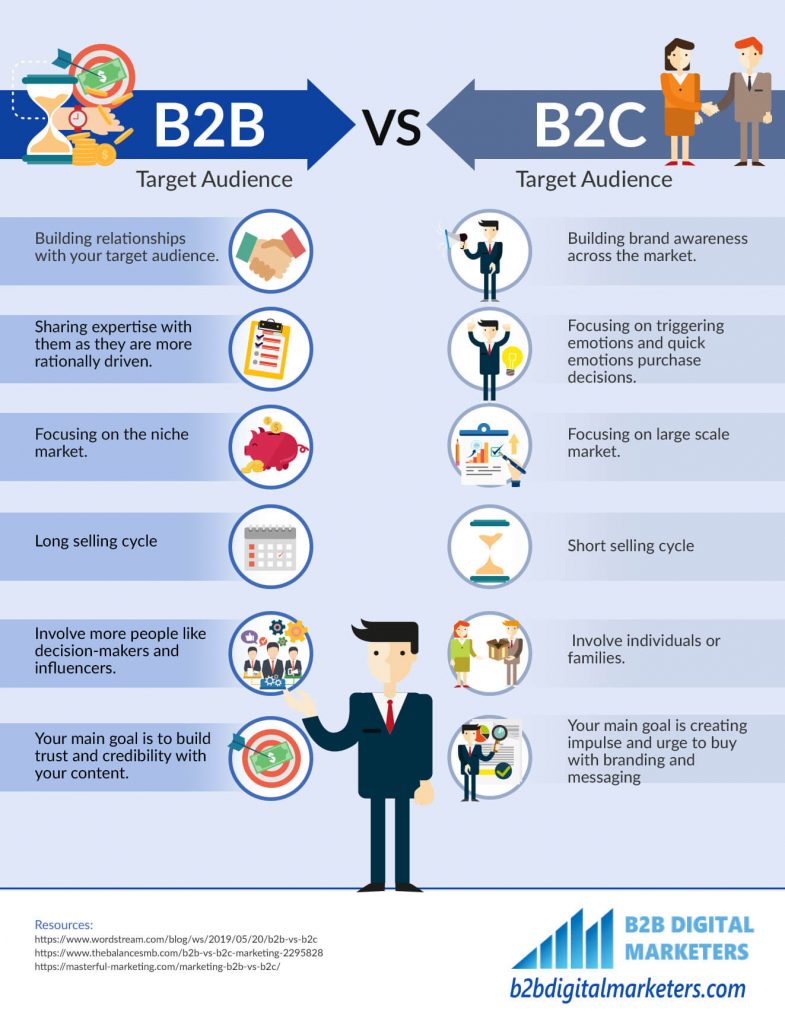
But make no assumptions here. We’re talking about data-driven insights. Surveys, interviews, and market research — these are the key insights that’ll help you find the right B2B buyers.
As a general rule, B2B buyer personas should include the following:
- Psychographic information
- Demographic information
- Buying behavior
- Pain points
- Job profile
When you have a well-defined buyer persona, you unlock a compass that’ll help point you toward making smart marketing decisions that drive conversions.
3. Choose the appropriate distribution channels
Let’s face it. Your content marketing budget doesn’t grow on trees. So you’ve got to make sure every penny counts, right?
You’ve got a library of awesome content tailored to your buyer personas. Great! But if it’s not reaching your audience, it’s like throwing money into the wind. That makes distribution channels as important as the content itself.
Are your B2B buyers hanging out on LinkedIn? Then start prospecting on LinkedIn. Do they devour industry blogs or trade publications? Then put your content where they’ll see it.
Consider utilizing B2B marketing tools like marketing automation platforms, CRM systems, and analytics software to streamline your distribution efforts and maximize your reach.
Publishing content isn’t about throwing spaghetti at the wall and seeing what sticks. It’s about strategic decisions based on data. Analyze your buyer personas, market research, and previous marketing efforts to see what channels perform best.
And keep this in mind: the perfect distribution channel for one type of content might not work for another. Effective content management is crucial for optimizing reach and engagement, and exploring the advantages of using headless CMS seamlessly aligns with modern content strategies, offering flexibility and efficiency in delivering your message.
A well-researched white paper might shine on your company blog, while a quick how-to video could go viral on social media.
For instance, beyond its entertaining content, TikTok is often an underutilized channel for B2B marketing. By strategically adding a link to your TikTok bio, you provide a seamless gateway for interested viewers to explore your offerings, drive traffic to your website, or create a buzz around your upcoming product launch.

Use a social media analytics tool like Keyhole and add your social media profiles. Schedule unlimited posts, compare your performance, and find the channel with most engagement. You can also add your competitors’s profile and execute a similar strategy.
So find where your audience is hanging out and then publish away. This extra step will help you get more bang for your buck and make sure your precious content doesn’t end up in the internet abyss.
Wrapping up
There you have it. Five top strategies for boosting your B2B brand promotion with content marketing that don’t focus on fancy jargon or quick fixes.
It’s about building genuine connections, creating valuable content, and executing smart strategies.
The world of content marketing is ever-evolving, so stay flexible, informed, and focused. Use these tips as your compass to navigate the waters, and you’ll be well on your way to building a B2B brand that resonates.
Now, over to you. We can’t wait to see what you accomplish. Stay tuned for more insights, and until then, start a free trial with Keyhole to elevate your marketing efforts!
Related Articles
131 Astonishing Social Media Statistics Revealed[2024 Edition]
How To Measure Social Media Engagement Rate: A Complete Guide
Author Bio

Vergine Melkonyan writes mostly SaaS and marketing content that helps customers to easily perform web scrapings, automate time-consuming tasks and be informed about latest tech trends with step-by-step tutorials and insider articles.
Frequently Asked Questions
1. What is content marketing in a B2B context?
Content marketing in a B2B context refers to creating and sharing valuable, relevant content to attract, engage, and retain a clearly defined audience of business buyers. It's about understanding these businesses' specific needs, challenges, and goals, and delivering content (blog posts, white papers, case studies, webinars, etc.) that speaks to these points. The goal of B2B content marketing is to position your business as a trusted resource and thought leader in your industry.
2. How can I measure the success of my B2B content marketing strategies?
You can measure the success of your B2B content marketing strategies with a variety of metrics. For example, if your goal is to increase brand awareness, you might measure website traffic, social media impressions, or the number of new newsletter sign-ups. If your goal is lead generation, you might track the number of form submissions, content downloads, or sign-up for a free trial. Other metrics could include engagement rates (likes, shares, and comments), email open and click-through rates, or even direct sales from specific content pieces.
3. Can small businesses also benefit from these B2B content marketing strategies?
Absolutely! Regardless of the size of your business, these B2B content marketing strategies can be highly effective. In fact, for small businesses, content marketing can be a cost-effective way to compete with larger players.
By producing high-quality content that addresses the needs and interests of your target audience, you can build credibility, improve online visibility, and foster meaningful relationships with potential customers.